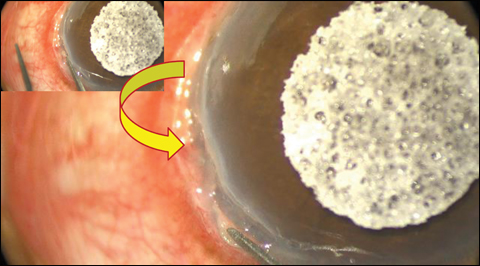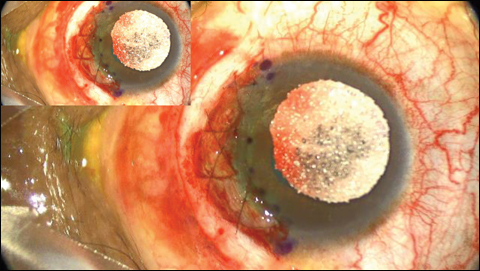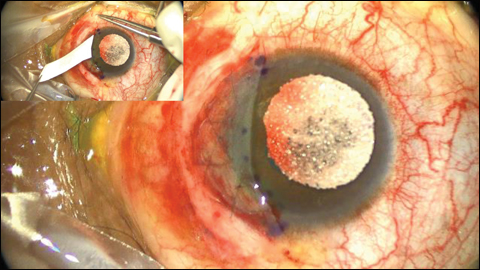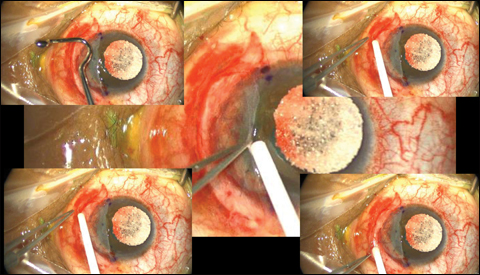Amniotic membrane can be used to manage Mooren’s ulcer with descemetocele
The technique consists of a two-layered cryopreserved amniotic membrane transplant, conjunctival recession and intraconjunctival corticosteroid injection.
Mooren’s ulcer is a rare disorder that may require surgical intervention. Although Mooren’s ulcer can occur in both sexes at any age, it is usually seen in adult men who are otherwise healthy with often no detectable systemic illness. The exact etiology of Mooren’s ulcer remains unidentified to date, even though this condition was first described as early as 1849 by Bowman and further characterized by Mooren in 1863. Both cell-mediated and humoral immune mechanisms have been implicated in the possible pathogenic pathway, leading to peripheral corneal melt and corneal ulceration.
Based partly on laterality and disease severity, Mooren’s ulcer is divided into three main types: limited type, malignant type and indolent type (Table). A clinical pearl to keep in mind is that some of these patients may have intense ocular pain that is out of proportion to the ocular inflammatory findings. The symptomatic spectrum includes photophobia, redness, tearing and blurred vision, while signs include the typical peripheral corneal ulceration with a steep overhanging edge with limbal involvement. Adjacent conjunctival inflammation is usually evident. In addition to topical medical therapy, systemic immunosuppressive chemotherapy is usually indicated, and ocular surgical intervention becomes necessary when globe integrity is threatened by the ulceration or if there is a corneal perforation.
In this column, I describe a surgical technique of amniotic membrane transplantation with combined fibrin glue and sutures, conjunctival recession and intra-conjunctival corticosteroid injection for the management of Mooren’s ulcer with descemetocele.
The technique
Monitored anesthesia care or general anesthesia may be used, depending on surgeon and patient preference. This surgical technique that I describe comprises a two-layered cryopreserved amniotic membrane transplant (Bio-Tissue), conjunctival recession and intraconjunctival corticosteroid injection.
Mooren’s ulcer typically involves the peripheral cornea with limbal involvement and usually has a steep overhanging edge with neighboring conjunctival inflammation (Figure 1). The presence of a descemetocele combined with a fairly extensive peripheral corneal ulceration warrants surgical intervention. After marking the corneal surface with a sterile marking pen, superficial keratectomy is performed using a straight crescent blade (Figure 2). The carrier sheet with the cryopreserved amniotic membrane is then cut to the required size, and the amniotic membrane is placed on the ocular surface with the stromal side down; subsequently it is tucked into the region of the peripheral corneal ulceration and placed in an accordion fold (Figures 3 to 5).


Images: John T




The conjunctival tissue next to the Mooren’s ulcer is demarcated with a sterile marking pen (Figure 6), blunt and sharp dissection is carried out to expose the bare sclera, and bleeding is controlled by using a disposable cautery (Figure 7). Tisseel Lyo (fibrin glue, Baxter) has two components, fibrinogen and thrombin, and these are applied to the cryopreserved amniotic membrane to attach it to the tissue in the region of the corneal ulceration (Figure 8). Next, a figure 8 suture pattern is created using 10-0 nylon sutures on a CU-5 needle (Alcon). These sutures provide additional anchoring support to the glued amniotic membrane in the region of the corneal ulceration (Figure 9). It is important to avoid overtightening these sutures to prevent any suture cheese wiring. A no-touch suturing technique is used while passing the needle on the corneal side and scleral side, and the needle curvature is followed to avoid needle deformation (Figure 9).
Figure 10 shows the completed suture pattern of multiple figure 8 suture configurations. Care should be taken to avoid cutting the sutures with the needle tip. A second layer of cryopreserved amniotic membrane is placed in this region, straddling the limbus and covering the first amniotic membrane, and the region of the bare sclera; it is attached with fibrin tissue adhesive and two 10-0 Vicryl sutures and ironed with a muscle hook for uniform attachment to the underlying sclera (Figures 11 to 13). The cut edge of the amniotic membrane approximates the conjunctival cut edge. Intraconjunctival injection of Kenalog (triamcinolone acetonide, Bristol-Myers Squibb) is administered, close to the cut recessed margin of the conjunctival tissue, and this concludes the surgical procedure (Figures 14 and 15). The second layer of amniotic membrane establishes a smooth, uniform ocular surface for proper lubrication with tears, controls inflammation, and augments and restores globe integrity.










- References:
- Chow CY, et al. Int Ophthalmol Clin. 1996;36(1):1-13.
- Foster CS. Ophthalmology. 1985;doi:10.1016/S0161-6420(85)33845-9.
- John T. Mooren’s ulcer. In: John T, ed. The Chicago Eye and Emergency Manual. Jaypee-Highlights Medical Publisher Inc.; 2011.
- Mooren A. Ophthalmiatrische Beobachtungen. 1867:107.
- Nettleship E. Trans Ophthalmol Soc UK. 1902;22:103-144.
- Watson PG. Eye (Lond). 1997;doi:10.1038/eye.1997.74.
- For more information:
- Thomas “TJ” John, MD, is a clinical associate professor at Loyola University at Chicago and in private practice in Oak Brook, Tinley Park and Oak Lawn, Ill. He can be reached at email: tjcornea@gmail.com.
Disclosure: John reports he is a consultant for, is on the speaker bureau of and has a stock interest in Bio-Tissue Inc.
